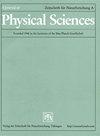费米金属中的低温小角电子-电子散射速率
IF 1.3
4区 物理与天体物理
Q4 CHEMISTRY, PHYSICAL
Zeitschrift Fur Naturforschung Section A-A Journal of Physical Sciences
Pub Date : 2023-09-25
DOI:10.1515/zna-2023-0099
引用次数: 0
摘要
摘要从欧姆定律出发,对费米金属中的低温元素电导率公式进行了评述。这为理解有效的质量效应和复杂的散射率(即使在低温下存在小角度电子-电子散射)所导致的方程为何以及如何复杂提供了必要的背景。利用推导德鲁德电导率公式的数学条件和物理参数,我们得到了我们的主要结果——低温下的解析散射率公式,它产生了著名的t2依赖关系,没有任何特别常数。我们的推导正式证明了公式1 / τ = (A / h) (k B T) 2 / E F $1/\tau =(A/\hslash ){({k}_{\text{B}}T)}^{2}/{E}_{\text{F}}$首先由Ashcroft和Mermin猜测是正确的,其中A = N杂质/4 π 2, N杂质是给定样品中存在的杂质(或散射中心)的数量。我们还强调了一个新的基本物理常数的发现,λ Arulsamy = 3 π 2 (4 π ε 0) 2 / m el e 4 ${\lambda }_{\text{Arulsamy}}=\left[3{\hslash }^{2}{(4\pi {{\epsilon}}_{0})}^{2}\right]/\left[{m}_{\text{el}}{e}^{4}\right]$,它将量子力学能与热能能联系起来,也与Rydberg常数有关。本文章由计算机程序翻译,如有差异,请以英文原文为准。
Low-temperature small-angle electron-electron scattering rate in Fermi metals
Abstract Low-temperature elementary conductivity formula in Fermi metals is reviewed starting from Ohm’s law. This provides the background needed to understand why and how the equations exploited are complicated due to effective mass effect and complex scattering rate even in the presence of small-angle electron-electron scattering at low temperatures. Using the mathematical conditions and physical arguments exploited to derive the Drude conductivity formula, we arrive at our main result—the analytic scattering rate formula at low temperatures that gives rise to the famous T 2 dependence without any ad hoc constants. Our derivation formally proves that the formula, 1 / τ = ( A / ℏ ) ( k B T ) 2 / E F $1/\tau =(A/\hslash ){({k}_{\text{B}}T)}^{2}/{E}_{\text{F}}$ first guessed by Ashcroft and Mermin to be correct where A = N impurity /4 π 2 and N impurity is the number of impurities (or scattering centers) present in a given sample. We also highlight the discovery of a new fundamental physical constant, λ Arulsamy = 3 ℏ 2 ( 4 π ϵ 0 ) 2 / m el e 4 ${\lambda }_{\text{Arulsamy}}=\left[3{\hslash }^{2}{(4\pi {{\epsilon}}_{0})}^{2}\right]/\left[{m}_{\text{el}}{e}^{4}\right]$ that associates quantum mechanical energy with that of thermal energy, and is also related to Rydberg constant.
求助全文
通过发布文献求助,成功后即可免费获取论文全文。
去求助
来源期刊
CiteScore
3.00
自引率
5.60%
发文量
81
审稿时长
3.3 months
期刊介绍:
A Journal of Physical Sciences: Zeitschrift für Naturforschung A (ZNA) is an international scientific journal which publishes original research papers from all areas of experimental and theoretical physics. Authors are encouraged to pay particular attention to a clear exposition of their respective subject, addressing a wide readership. In accordance with the name of our journal, which means “Journal for Natural Sciences”, manuscripts submitted to ZNA should have a tangible connection to actual physical phenomena. In particular, we welcome experiment-oriented contributions.

 求助内容:
求助内容: 应助结果提醒方式:
应助结果提醒方式:


